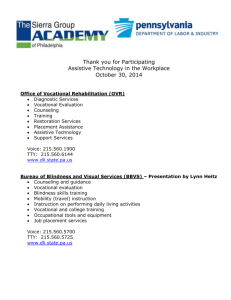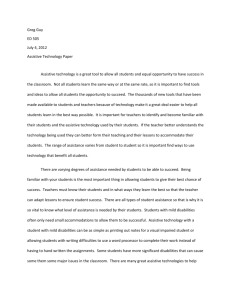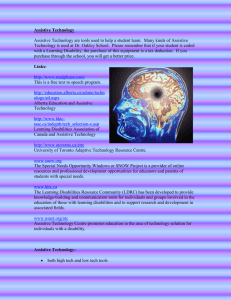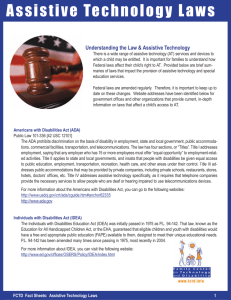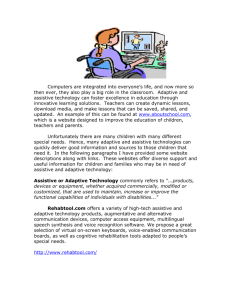Assistive Technology - ED505-Tues
advertisement
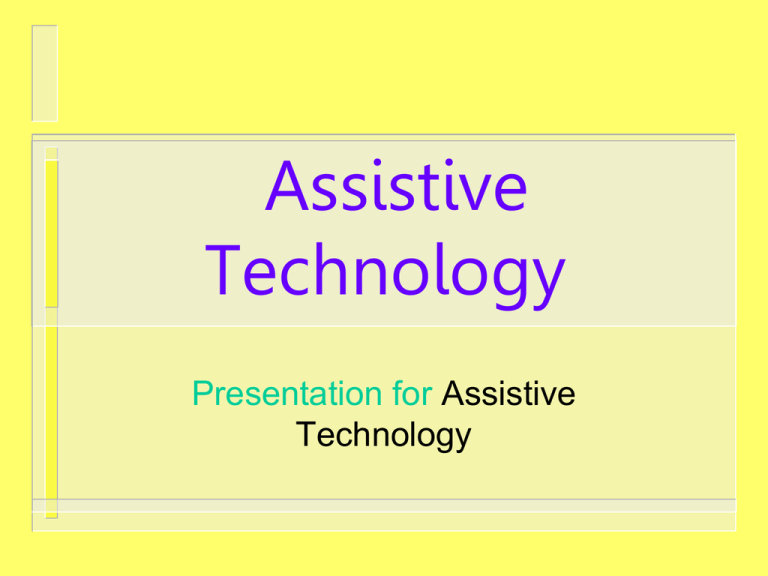
Assistive Technology Presentation for Assistive Technology Facts about Assistive Technology • • • With appropriate use of this technology, teachers have access to valuable instructional tools which can be used to enhance student learning and achievement for all students, including those with disabilities. Instructional technology can be used to reinforce the individualized educational programs which are provided through special education programs. Many students with disabilities also require assistive technology to access instructional technology available within the classroom and to benefit from their educational programs. These computer technology solutions include adaptive input devices, adaptive output devices, and adaptive software. This technology provides educators and students with tools for active participation, achievement, and inclusion for students with disabilities. Today we will discuss frequently used computer-based assistive technology solutions. Introduction Assistive Technology Any device or process that assists a person with a disability to do something that would otherwise be difficult or impossible to accomplish. Common examples of assistive technology……. •Hearing aids •Wheelchairs, walkers, canes •Eyeglasses Who Uses Assistive Technology? Students with…. Sensory Impairments Orthopedic Impairments Learning Disabilities Intellectual Impairments Other Health Impairments Students with disabilities including •sensory impairment (blind or deaf) •orthopedic impairment (reduced or absent ability to move parts of the body in a normal way, such as in cerebral palsy.) •learning disabilities •intellectual impairments (mental retardation) •other health impairments (such as muscular dystrophy) Educational Assistive Technology These are the various categories of assistive technology that our students may use in the educational environment… Adapted Toys and Games Aids for Daily Living Devices to help students in their self-care, such as eating and dressing. Examples: a zipper pull for a student who has fine motor difficulties for dressing a weighted spoon for a student who has impaired arm movements for self-feeding Aids for Hearing Impaired Students Aids for Visually Impaired Students Augmentative Communication Learning Aids Computer Adaptations The focus of the remaining portion of this presentation will be regarding computer adaptations. For students with disabilities, it may be necessary to adapt the computer input system, the computer output system, or use adapted software. Computer Adaptations…. Adapted Input Devices/Systems Adapted Output Devices/Systems Adapted Software Computer Input Adaptations Adaptive Pointing Devices – – – Hand-held pointers Mouth sticks Head pointers Keyboard Adaptations – – – Key-guard Tactile locator dots and cue stickers Speech feedback Keyboard Utilities Have class go into control panel and experiment with the keyboard and mouse settings. Talk about “who” might benefit from these modifications. By slowing the repeat rate, a student will have additional time to “get off” of the key, without getting repeat letters. Sticky Keys allows a one-handed user to capitalize. When Sticky Keys is on, the user will hit “shift” and then the next key will be the shifted key. Point out ability to slow mouse/cursor movement under “motion.” Good for students with hand-eye dis-coordination. Keyboard Alternatives Enlarged keyboards Mini keyboards Touch screens On-screen keyboards Micro-switch interface Voice recognition software Braille input Mouse Alternatives Trackball Trackpad Joystick Headmouse Mindmouse Adapted Computer Output Utility Applications Screen Enlargement Programs Talking Word Processors Screen Reading Programs Braille Embossers Examples of Adapted Software Our goal as special educators is to facilitate use of regular classroom software with special education students whenever possible. However, there may be need for specialized software to help our students compensate for their disabilities. Federal Mandates IDEA Section 504 of the Rehabilitation Act ADA These legislative documents mandate that students with special needs have a free and appropriate education that maximizes their learning potential and them gives them equal access to the learning environment. IDEA mandates that each student in special education be considered for assistive technology. This requires that educators be aware of assistive technology, who may benefit from assistive technology, and what assistive technology can do for your students. ADA and Section 504 of the Rehab Act assure that all persons with disabilities will have equal access to opportunities as the non-disabled population. Americans with Disabilities Act ( ADA ) Public Law 101-336 [42 USC 12101] The ADA prohibits discrimination on the basis of disability in employment, state and local government, public accommodations, commercial facilities, transportation, and telecommunications. The law has four sections, or “Titles”. Title I addresses employment, saying that any employer who has 15 or more employees must offer “equal opportunity” to employment-related activities. Title II applies to state and local governments, and insists that people with disabilities be given equal access to public education, employment, transportation, recreation, health care, and other areas under their control. Title III addresses public accommodations that may be provided by private companies, including private schools, restaurants, stores, hotels, doctors’ offices, etc. Title IV addresses assistive technology specifically, as it requires that telephone companies provide the necessary services to allow people who are deaf or hearing impaired to use telecommunications devices. For more information about the Americans with Disabilities Act, you can go to the following websites: http://www.usdoj.gov/crt/ada/cguide.htm#anchor62335 http://www.ada.gov Individuals with Disabilities Education Act (IDEA) The Individuals with Disabilities Education Act (IDEA) was initially passed in 1975 as P.L. 94-142. That law, known as the Education for All Handicapped Children Act, or the EHA, guaranteed that eligible children and youth with disabilities would have a free and appropriate public education (FAPE) available to them, designed to meet their unique educational needs. P.L. 94-142 has been amended many times since passing in 1975, most recently in 2004. For more information about IDEA, you can visit the following website: http://www.ed.gov/offices/OSERS/Policy/IDEA/index.html Section 508 of the Rehabilitation Act 29 U.S.C. § 794d Section 508 of the Rehabilitation Act requires that all electronic and information technologies developed and used by any Federal government agency must be accessible to people with disabilities. This includes websites, video and audio tapes, electronic books, televised programs, and other such media. Individuals with disabilities may still have to use special hardware and/or software to access the resources. Section 508 does not apply to the private sector or to organizations that receive Federal funds. More information about Section 508 can be found at: http://www.section508.gov/index.cfm?FuseAction=Content&ID=12 http://www.itpolicy.gsa.gov/cita http://www.ataporg.org/itqa.asp Assistive Technology Act of 1998 Public Law 105-394 [29 USC 2201] The Assistive Technology Act, also known as the “Tech Act” provides funds to states to support three types of programs: •the establishment of assistive technology (AT) demonstration centers, information centers, equipment loan facilities, referral services, and other consumer-oriented programs; •protection and advocacy services to help people with disabilities and their families, as they attempt to access the services for which they are eligible; •Federal/state programs to provide low interest loans and other alternative financing options to help people with disabilities purchase needed assistive technology. For a list of state projects funded under the Tech Act, visit http://www.ataporg.org/stateatprojects.asp Carl D. Perkins Vocational and Technical Education Act Amendments of 1998 Public Law 105-332 Section 1 (b) [20 USC 2302] Schools are required to integrate academic, vocational and technical training, increase the use of technology, provide professional development opportunities to staff, develop and implement evaluations of program quality, expand and modernize quality programs, and link secondary and post-secondary vocational education. Additionally, states must submit an annual report on how special populations, including persons living with disabilities, engaged in vocational education are faring relative to the states’ performance goals. http://www.ed.gov/offices/OVAE/CTE/legis.html Fair Housing Act Amendments of 1988 Public Law 100-430 [42 USC 3604] This legislation addresses non-discrimination issues for potential tenants with disabilities. It is unlawful to deny housing to a renter/buyer because of a disability that the person may have. Owners must also make reasonable exceptions to their policies to accommodate people with disabilities (i.e. - Seeing Eye dogs). Tenants are also allowed to make reasonable access-related modifications to the property if necessary. http://www4.law.cornell.edu/uscode/unframed/42/3604.html The Hearing Aid Compatibility Act of 1988 Public Law 100-394 [47 USC 610 (b)] This law requires that all telephone equipment manufactured or imported for use in the United States after August 1989 be compatible with hearing aids. http://www4.law.cornell.edu/uscode/unframed/47/610.html The Television Decoder Circuitry Act of 1990, Section 3 Public Law 101-431 [47 USC 303 (u)]. The deaf and hearing impaired should have access to information and entertainment via television medium to the fullest extent possible through technology. This law requires that new televisions with at least a 13inch screen must have the built-in capacity to display closed-captioned TV transmissions. http://www4.law.cornell.edu/uscode/unframed/47/303.html Telecommunications Act of 1996 Title I - Public Law 104-104 [47 USC 255] This law requires that telecommunications equipment and services be accessible to and usable by persons with disabilities. http://www4.law.cornell.edu/uscode/unframed/47/225.html Title III - Public Law 104-104 [47 USC 613] Discusses rules on closed captions and video descriptions of video programming. http://www4.law.cornell.edu/uscode/unframed/47/613.html Federal Government Procurement of Accessible Information Technology Public Law 105-220 section 408 [29 USC 794 (d)] Individuals with disabilities cannot be excluded from the participation in, be denied the benefits of, or be subjected to discrimination under any program or activity receiving Federal financial assistance or under any program or activity conducted by any Executive agency or by the United States Postal Service. Workforce Investment Act of 1998 Public Law 105-220 (29 USC 701) In the vocational rehabilitation process, this law defines technology and its use in job planning, and acquisition and retention of people with disabilities. http://www4.law.cornell.edu/uscode/unframed/29/701.html Where do you go for help? Local school – – Special education teachers Special education coordinator Assistive Technology Examples "The term assistive technology device means any item, piece of equipment, or product system, whether acquired commercially off the shelf, modified, or customized, that is used to increase, maintain or improve functional capabilities of children with disabilities." Variable speech control tape-recorder (VSC) can help the individual who has difficulty processing speech; it enables the user to play back audiotaped material at a slower or faster rate than it was initially recorded without the loss of intelligibility/voice quality. Increasing the playback rate is helpful when reviewing lecture notes, as well as for practice in strengthening listening skills; the option to decrease the rate is helpful in re- listening to taped textbooks, etc. With the use of an OCR system with speech synthesis , an individual with poor reading skills, yet strong receptive oral language abilities, is able to read and, thus, comprehend with greater ease. OCR systems provide a means for directly inputting printed material into a computer and displaying it on the computer screen. The input is accomplished through a full-page scanner that scans an entire page at once or a hand-held scanner that the user moves across or down the page of material. Another option available is the use of a hand-held wand that is used to scan single words or phrases at a time. When used with voice output , the scanned material can be read back, thus creating what can be thought of as a "reading machine."


